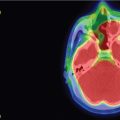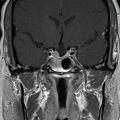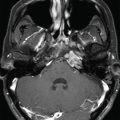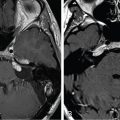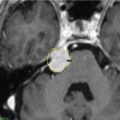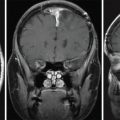| SKULL BASE REGION | Petroclival/jugular foramen |
| HISTOPATHOLOGY | Paraganglioma |
| PRIOR SURGICAL RESECTION | Embolization |
| PERTINENT LABORATORY FINDINGS | N/A |
Case description
This 44-year-old woman was investigated for left hypoacusis, tinnitus, and left hemitongue hypoesthesia and hypomobility. Imaging was compatible with paraganglioma of the jugular foramen, with infiltration of the occipital condyle and lateral portion of the clivus. An embolization procedure was performed prior to the planned surgery. However, surgery was canceled due to the development of significant new deficits such as dysphonia, swallowing difficulties, and left facial weakness (House-Brackman [HB] grade 2). Radiological follow-up showed a reduction in the volume of the lesion due to internal necrotic cystic degeneration, which was associated with partial resolution of symptoms. At 3-year follow-up, brain magnetic resonance imaging (MRI) revealed tumor progression ( Figure 10.53.1 ). Multisession stereotactic radiosurgery (SRS) (25 Gy in 5 fractions at the isodose of 82%) was performed using CyberKnife ( Figure 10.53.2 ). Follow-up imaging at 5 years showed a volumetric reduction of the lesion. From a neurological point of view, improved left facial deficit (HB1) and stabilization of other cranial deficits were also observed.
| Radiosurgery Machine | CyberKnife |
| Radiosurgery Dose (Gy) | 25, at the 82% isodose line |
| Number of Fractions | 5 |


| Critical Structure | Dose Tolerance |
|---|---|
| Brainstem |
|
| Lower cranial nerves | 25–30 Gy in multifraction SRS |
Stay updated, free articles. Join our Telegram channel

Full access? Get Clinical Tree



